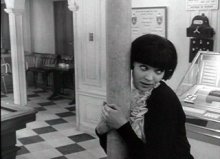Is It Really a Great Movie? Part Twelve: My Life to Live
by dan heaton
Using Roger Ebert's Great Movies book as a guide, this series of articles will focus on all films included on his list that previously have escaped my notice. Since all lists are subjective, I am not treating Ebert's choices as the essential selection of films. However, his essays offer the perfect chance for me to explore both classics and lesser-known pictures from around the globe.

Jean-Luc Godardís My Life to Live may not receive the international acclaim of his 1960 film Breathless, but many experts have heralded it as a classic picture. The Venice Film Festival bestowed the Special Jury Prize and the Pasinetti Award (Best Italian Film) on the unique 1962 film. Franceís Godard was the epitome of cool in the Ď60s, and his movies retain their modern style long after their initial release. The sharp black-and-white images, chic clothes, and constant smoking only enhance this filmís staying power.
My only prior exposure to Godard was seeing 1964ís Band of Outsiders, which offered great scenes but fell a bit short on the emotional side. One exciting dance sequence had some close similarities with Pulp Fictionís Travolta/Thurman combo, which is not a mere coincidence. Tarantinoís cool characters honor (or steal from) Godardís best work, and those parallels are evident in My Life to Live. The story comprises 12 individual scenes that each focus on Nana (Anna Karina) Ė a comely lady who leaves her husband to pursue an acting career. Unfortunately, her aspirations lead nowhere, and she slips into a life of prostitution. Her demeanor is extremely subdued even when she deals with guys who are not at the top of the social scale. Nana remains the epitome of cool through nearly everything, but her smooth demeanor fails to mask the emotional turmoil residing beneath the surface. Sporting short black hair and smoking incessantly, she lacks much outward emotion but is affected by her associateís harsh actions.
The filmís highlights include two lengthy sequences that could hardly be more different. Each moment almost exists in an entirely separate genre from the other, but that disparity adds to the effectiveness. The first involves Nanaís pimp Raoul (Sady Rebbot), who spends considerable time discussing the intricacies of the prostitution business. His words are cold and direct and vary little from how a corporate boss might speak to a new office worker. The storyís energy picks up at this point, which is eerie considering the profession being described. The other pivotal scene involves a random conversation between Nana and an old man at a local cafe. Their philosophical discussion covers the nature of life and our place in it. He relates an odd story that intrigues Nana, and their conversation feels far removed from her passionless trysts.
The twelve sections are separated by titles and extremely brief summary descriptions. While they all contain Anna Karina and Michel Legrandís remarkable score, each moment could exist separately from the rest. The story does progress broadly towards its surprising conclusion, but this result is not really the point. Even while Nanaís life denigrates, exciting small moments and Godardís sharp direction keep us engaged. One memorable scene involves her viewing The Passion of Joan of Arc (my next article!) and tearing up while Maria Falconetti cries on the screen. Karina commands our attention, and her success is largely due to the cameraís loving gaze. She was Godardís wife at the time, and their connection is evident during this film. Nana spends her time smoking and often doing very little, but Karina makes even the throwaway moments interesting. I should also mention Raoul Coutardís excellent cinematography, which gives the scenes a contemporary, unique perspective.
My Life to Live is not a groundbreaking picture, but its effect stays with you long after the viewing. Roger Ebert describes how the film left him motionless through the presentation, and I agree with this sentiment. Godard, Karina, Legrand, and Coutard use their talents to grab you for the entire running time. I would not place this picture at the top of this seriesí choices, but its appeal is undeniable. One of the Great Movies projectís primary goals was to discover artistsí work that would motivate me to explore them further. This intriguing picture has inspired me to seek out Godardís other notable films in the near future.
Copyright (c) 2007 erasing clouds |
|